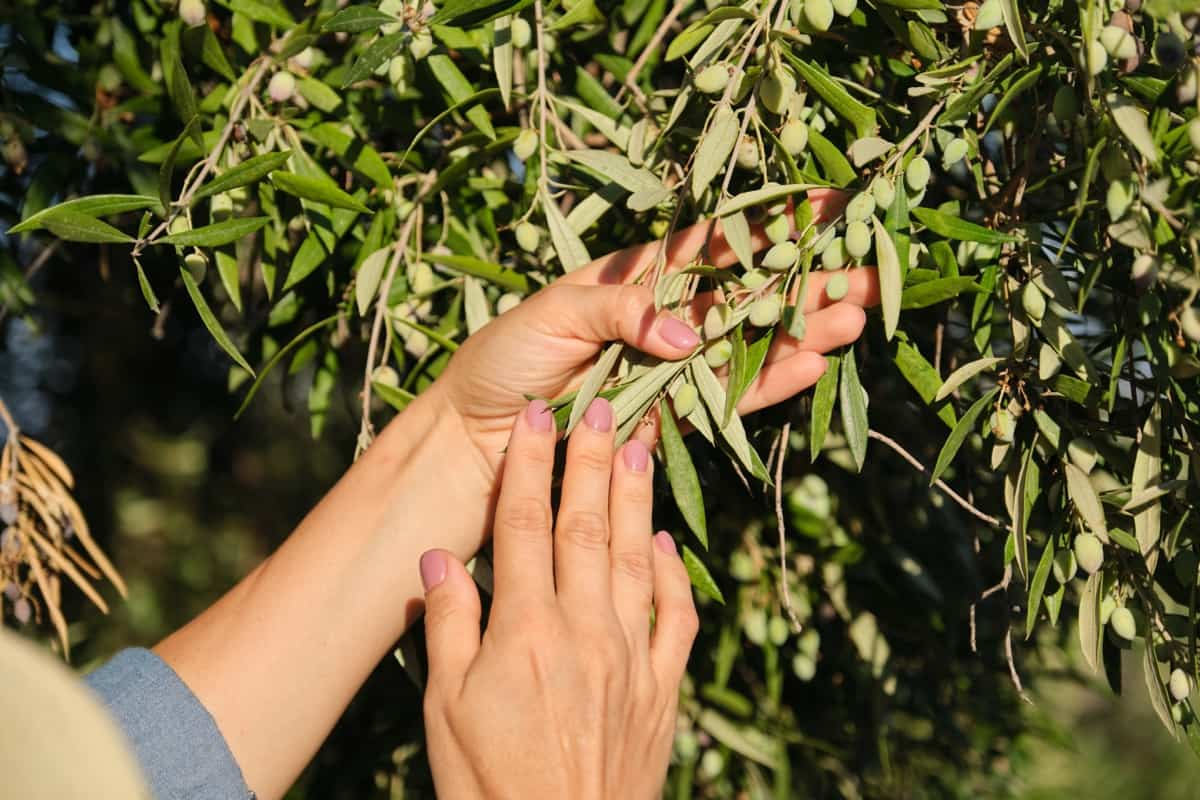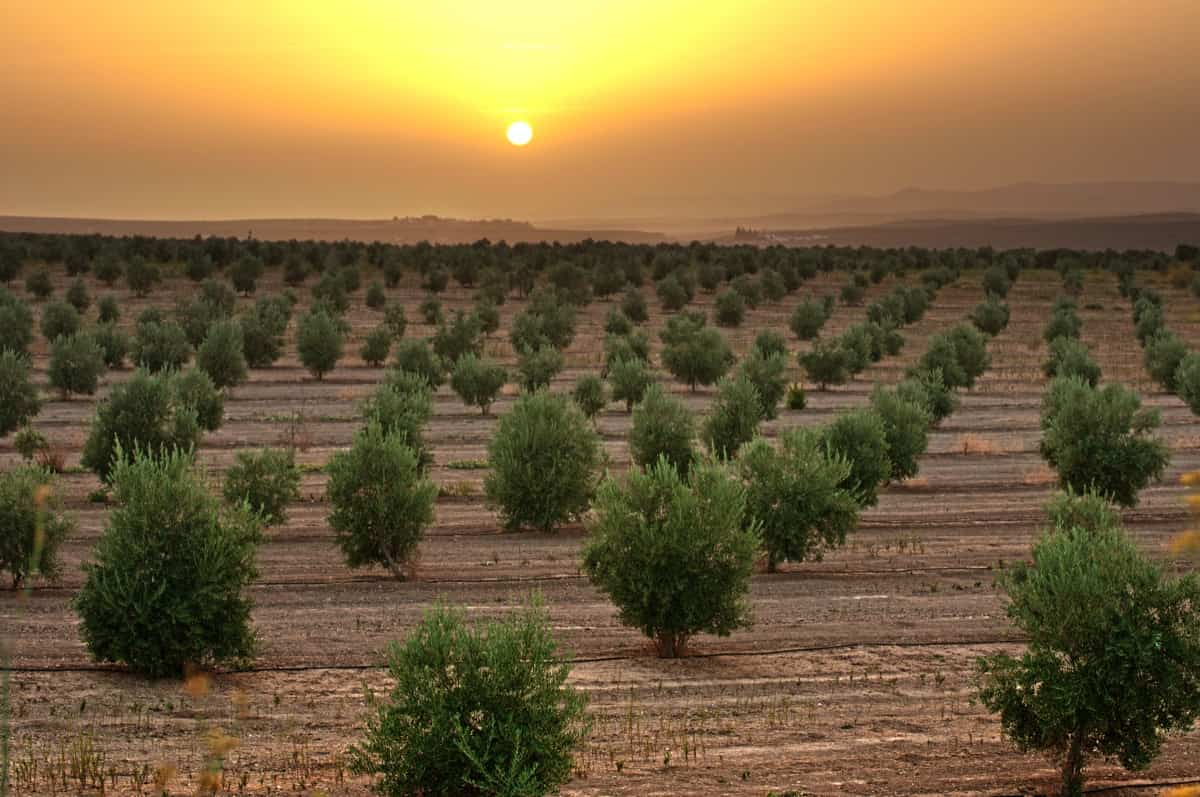Olives are the fruits produced by trees from the family Oleaceae. They can be utilized for consumption (table Olives) or to produce Olive oil. By growing Olive trees organically, you can ensure that the Olives produced are free from harmful chemical residues. Growing Olive trees organically requires a solid understanding of the fundamental principles behind this sustainable and eco-friendly approach. Adopting organic methods can produce healthy Olives and contribute to a healthier environment.

How to Grow Olive Trees Organically
Selecting the Right Olive Tree Varieties for Organic Growth
- Frantoio: This Italian variety is known for its high oil content and rich flavor. It produces medium-sized Olives with a distinct peppery taste, perfect for Olive oil production.
- Leccino: Another Italian variety, Leccino is prized for its mild flavor and versatility. Its small to medium-sized fruit can be used as table Olives or pressed into oil.
- Arbequina: Originally from Spain, Arbequina is a smaller-sized Olive with a delicate flavor profile. It adapts well to various climates and is ideal for oil production and pickling.
- Pendolino: Native to Italy, Pendolino is favored for its high productivity and excellent pollination capabilities. Its small fruits yield an aromatic oil with fruity notes.
- Sevillano: Originating from Spain, Sevillano Olives are large and commonly used as table Olives due to their meaty texture and slightly bitter taste.
Preparing the Soil for Organic Olive Tree Planting
Olive trees thrive in well-drained soil, so if yours is heavy clay or prone to waterlogging, consider improving its structure by adding organic matter such as compost or well-rotted manure. Once you’ve ensured good drainage, it’s time to test your soil’s pH level. The best soil pH for Olive trees is between 6 and 7. Adjust organic amendments like lime or sulfur according to the recommended application rates.
Planting Olive Trees: Step-by-Step Instructions for Organic Methods
- Select a location for growing Olives with plenty of sunlight and good drainage. Olive trees thrive in Mediterranean climates, so make sure your chosen spot mimics those conditions as closely as possible.
- Next, remove weeds or grass from the area by preparing the growing soil. Loosen the soil using a tiller and mix in some organic compost to improve fertility.
- Now, it’s time to plant your Olive tree. Dig a hole carefully twice as deep and wide as the root ball of a sapling. Gently remove the sapling from its container and place it in the hole, ensuring the root ball top sits slightly above ground level.
- Backfill with soil around the roots, firming it gently but not too tightly. Water thoroughly after planting to ensure good hydration for your new tree. After planting, regularly water during dry spells until your Olive tree becomes established. However, be careful not to overwater, as Olives prefer well-drained soil.
- Consider applying organic fertilizer annually in early spring as your Olive tree grows. Regular pruning is also important for maintaining healthy Olive trees. Remove dead or diseased plant branches and thin out crowded areas to promote airflow and reduce pest problems.
- Be vigilant about pest control using organic methods such as neem oil sprays when necessary. Regularly inspect leaves and fruit for signs of pests or diseases so you can take action promptly if needed.
In case you missed it: How to Prune Olive Tree in Pots and When to Prune Olive Tree in Pots

Providing Optimal Growing Conditions for Organic Olive Trees
- Sunlight: Olive trees thrive in full sunlight, so select a place that receives 6-8 hours of direct sunlight daily. This will help the tree develop strong branches and produce high-quality Olives.
- Soil type: Sandy loam or loamy soil is ideal for Olive cultivation as it allows proper root development and prevents waterlogging.
- Watering: While Olive trees are drought-tolerant, they need regular watering, especially during the first few years after planting. Water the plant deeply but infrequently to encourage deep root growth and avoid overwatering, which can lead to root rot.
- Mulching: Apply an organic mulch layer to the tree to retain moisture, regulate soil temperature, suppress weeds, and improve soil health. Use materials like straw or wood chips and replenish the mulch annually.
- Pruning: Regular pruning helps maintain your Olive tree’s shape while promoting airflow and sunlight penetration throughout its canopy. Prune during late winter or early spring before new growth begins using sharp pruning shears.
- Nutrition: Organic fertilizers such as compost or well-rotted manure can provide essential nutrients without harmful chemicals. Apply fertilizer to the Olive tree in early spring when new growth starts, following package instructions for application rates.
Watering and Irrigation Techniques for Organic Olive Tree Cultivation
Olive trees require regular watering but can also tolerate drought conditions. Overwatering the live trees can lead to root rot and other diseases, so monitoring soil moisture levels is necessary. One effective technique is deep watering. This involves providing a slow, steady water flow directly to the roots for an extended period. This helps the tree withstand dry periods.
Drip irrigation systems are commonly used in organic Olive orchards as they precisely control water distribution. Drip irrigation minimizes waste and ensures efficient hydration by delivering water directly to the base of each tree. Mulching is another helpful practice in organic Olive tree cultivation. Applying mulch around the tree’s base helps retain moisture in the soil, reducing evaporation and weed growth while improving overall soil health. Adjusting watering practices based on weather conditions and seasonal changes is essential.
Organic Fertilization Strategies for Healthy Olive Tree Growth
- Compost: Enrich the soil with nutrient-rich compost, adding organic matter and beneficial microorganisms.
- Cover Crops: Consider planting cover crops like clover or vetch between rows of Olive trees. These plants prevent erosion and fix nitrogen in the soil, providing natural fertilizer.
- Fish Emulsion: Use fish emulsion fertilizer as a source of nitrogen and trace minerals during the growing season. Dilute according to package instructions before applying near the base of your Olive tree.
- Manure Tea: Create an organic liquid fertilizer by steeping well-aged manure in water for several days until it forms a potent tea-like mixture. Use this diluted solution to feed your Olive trees periodically throughout the year.
In case you missed it: All About Black Olive Tree: Growing, Uses, Benefits, and Profile of Shady Lady Olive Tree

Pruning and Training Olive Trees Organically: Best Practices
- Timing: Prune your Olive trees during the dormant season, usually in early spring or late winter.
- Selective Pruning: Remove any dead or diseased branches first, followed by any crossed or crowded branches. Aim for an open canopy that allows sunlight to reach all parts of the tree.
- Shape Maintenance: Olive trees naturally have a distinctive shape characterized by a thick trunk and gnarled branches. Maintain this shape by selectively removing excessive growth while leaving enough foliage for photosynthesis.
- Training Methods: Choose between vase training or central leader training techniques depending on your desired end product.
Managing Pests and Diseases in Organic Olive Tree Orchards
Olive tree growers face one of the biggest challenges in managing pests and diseases without chemical pesticides. However, with careful planning and proactive strategies, keeping your Olive trees healthy organically is possible. Start by selecting disease-resistant Olive tree varieties known to be less susceptible to common ailments.
Providing optimal growing conditions such as proper soil preparation, sufficient sunlight, and adequate spacing between trees can help prevent pests and diseases. Regular orchard monitoring is crucial in identifying any signs of infestation or disease early. Integrated Pest Management (IPM) techniques can be highly effective in organic orchards. This approach involves using a combination of natural predators, traps, barriers, and beneficial insects to control pests naturally while minimizing environmental harm.
Practicing good sanitation measures also plays a significant role in pest management. By implementing these organic pest management strategies for Olive trees and proper cultural practices like regular pruning and fertilization, you can maintain healthy Olive trees without harmful chemicals.
Harvesting and Storing Organic Olives: Essential Guidelines
When it comes to harvesting organic Olives, timing is everything. Once your trees have reached maturity, typically after 3 to 5 years, it’s time to start reaping the rewards of your hard work. The ideal time for harvesting Olives will depend on climate, Olive variety, desired ripeness level for oil or table Olives, etc.
Generally speaking, Olives are harvested when they have reached their optimal stage of maturity. One important guideline during harvesting is to handle the fruit with care. After you’ve successfully gathered your precious crop of organic Olives from your trees’ branches or by shaking them onto nets spread under the tree canopy, it’s time to store them properly.
In case you missed it: How to Grow Dwarf Olive Tree: Size, Height, Price, Planting, and Care

Conclusion
Organic cultivation promotes a healthier ecosystem. Avoiding synthetic pesticides and fertilizers creates a balanced environment for beneficial insects and microorganisms to thrive. This natural balance helps sustainably control pests and diseases. Growing Olive trees organically supports sustainable agriculture practices that prioritize long-term environmental stewardship. By reducing dependence on synthetic inputs and promoting natural solutions for pest control and soil fertility management, organic farming helps preserve ecosystems for future generations.
- Feed Your Flock for Less: Top 10 Tips to Save on Chicken Feed
- Ultimate Guide to Ossabaw Island Hog: Breeding, Raising, Diet, and Care
- Hatching Answers: The Top 10 Reasons Your Chickens Aren’t Laying Eggs
- Eggs and Economics: Breaking Down the Cost of Raising Backyard Chickens
- Defend Your Greens: Proven Methods to Keep Iguanas Out of Your Garden
- Ultimate Guide to Cinnamon Queen Chicken: A Comprehensive Guide for Beginners
- Ultimate Guide to California Tan Chicken: Breeding, Raising, Diet, Egg-Production and Care
- Ultimate Guide to Marsh Daisy Chicken: Breeding, Raising, Diet, and Care
- 10 Types of Chicken Farming Businesses You Can Start for Profits